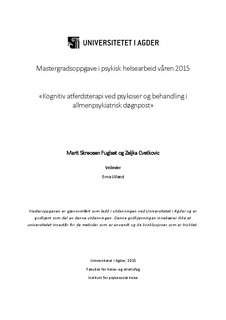| dc.description.abstract | In 2013, Directorate of Health published guidelines for assessment, treatment and monitoring of patients with psychotic disorders, with recommendations that cognitive behavioral therapy should be offered to all patients with psychosis symptoms as well as to be used in all treatment phases. The purpose of our study is to gain knowledge about how cognitive behavioral therapy can be used in public psychiatric inpatient wards.
The issue of our study is: How to use the principles and potential of cognitive behavioral therapy in the establishment of treatment programs for people with psychotic disorders in general psychiatric inpatient wards?
This is a qualitative hermeneutical study based on data from five semi-structured interviews with experts in cognitive behavioral therapy. Applied method of analysis is Malteruds systematic text condensation, inspired by Giorgis phenomenological analysis.
Findings: "Inpatient wards work according to a pragmatic style; cognitive behavioral therapy in psychosis provides meaningful structure in common understanding" and "Structure of the treatment is gradual, through bonding of knowledge."
Conclusion: Cognitive behavioral therapy's theoretical framework has the potential to be a bridge between the scientific-based practices that are still prevalent within specialist health care and the contextual practice of user involvement in focus, which is prevalent in mental health work. As a common theoretical superstructure in the ward it will be able to strengthen the interdisciplinary cooperation, with the goal of more comprehensive services for patients. The structure of cognitive behavioral therapy of psychosis by normalization and psychoeducation, may contribute to the experience of milieu therapy as meaningful and targeted. The service provided through the inpatient wards may be developed gradually through experience, as long as "a cognitive way of thinking" remains in focus.
Keywords: Cognitive behavioral therapy, psychosis, psychotic symptoms, cognitive milieu therapy, inpatient ward. | nb_NO |
